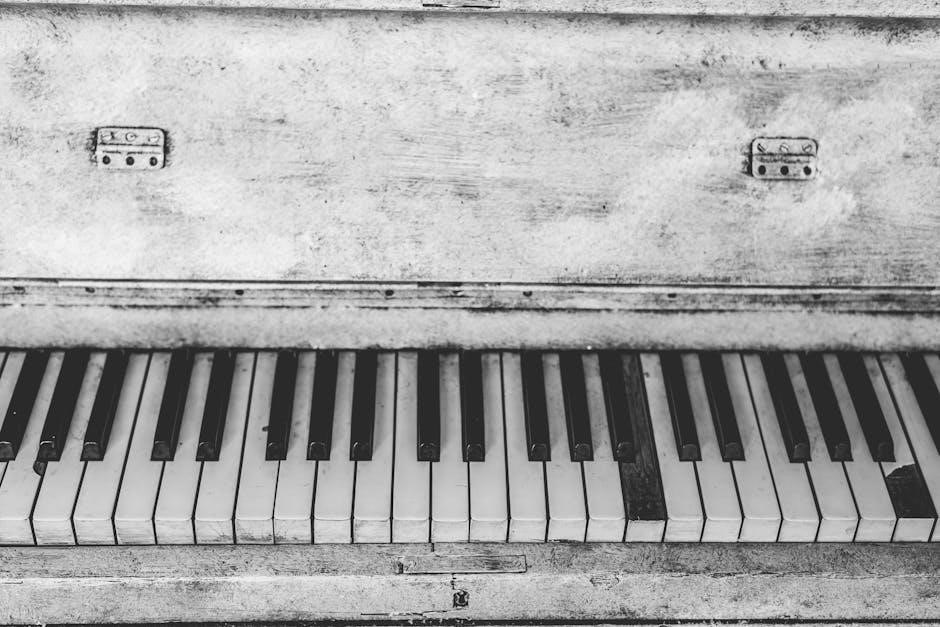“Let It Be” by The Beatles is a timeless ballad released in 1970, featuring Paul McCartney’s soothing piano melody and heartfelt lyrics, offering comfort and solace.
1.1 Historical Background of the Song
“Let It Be” was released in 1970 as part of the album of the same name, marking one of The Beatles’ final projects before their breakup. Written by Paul McCartney, the song was inspired by a dream he had about his mother, Mary, during a tumultuous time for the band. Its comforting message resonated deeply with fans, offering solace during uncertain times, both for the band and the world.
1.2 Significance of the Song in The Beatles’ Discography
“Let It Be” holds a special place in The Beatles’ discography, serving as a poignant farewell and a reflection of their evolving musical style. Its soaring piano melody and uplifting lyrics captured the essence of their later work, blending rock with classical influences. The song’s emotional depth and universality have cemented its status as a timeless classic, resonating across generations and solidifying its legacy as one of the band’s most enduring compositions.

Finding “Let It Be” Piano Sheet Music in PDF Format
Piano sheet music for “Let It Be” is widely available online, with free and paid options on platforms like MuseScore, Ko-fi, and SheetMusic-Free.com, catering to all skill levels.
2.1 Popular Websites for Downloading Free Piano Sheet Music
Pianists can find free “Let It Be” sheet music on websites like Piano Tutor and Scribd. These platforms offer downloadable PDFs, ideal for both beginners and experienced players. Additionally, Musicnotes provides free and paid versions, allowing users to choose based on their needs. These sites ensure easy access to high-quality sheet music for practice and performance.
2.2 Paid Resources for High-Quality Sheet Music
For high-quality sheet music, platforms like Musicnotes and MuseScore offer premium PDF downloads. These sites provide professionally arranged scores, including intermediate and advanced versions of “Let It Be.” Purchasing ensures access to accurate, licensed arrangements, ideal for serious pianists seeking precise notation and performance quality. These resources are worth the investment for those looking for polished, reliable sheet music.
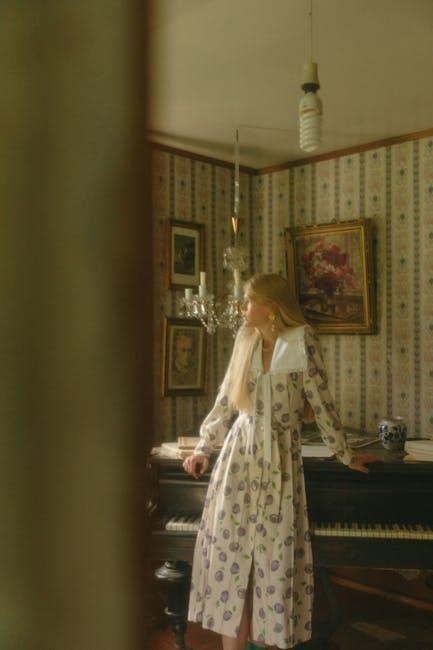
Structure of the Song for Piano Performance
The song features an iconic intro, followed by verses, a memorable chorus, and a climactic bridge, leading to a harmonious outro, perfect for piano performance.
3.1 Intro and Piano Solo
The intro of “Let It Be” features a serene piano solo, setting a calm tone with arpeggiated chords in C major. This opening melody, played by Paul McCartney, establishes the song’s emotional foundation. The solo’s simplicity allows for expressive interpretation, making it accessible for pianists of various skill levels. The gentle progression transitions smoothly into the verse, maintaining the song’s introspective mood.
3.2 Verse and Chorus Progressions
The verse and chorus of “Let It Be” follow a progression of C, G, Am, and F chords, creating a harmonic flow that supports the song’s lyrical depth. The piano accompaniment uses broken chords to maintain a steady rhythm, allowing the melody to shine. The chorus builds emotionally with the addition of seventh chords, enhancing the song’s uplifting message. This structure makes the song both memorable and pianistically rewarding.
3;3 Bridge and Climax
The bridge of “Let It Be” features a subtle yet powerful modulation, transitioning from C major to E flat major, creating a sense of emotional uplift. The climax is marked by a flowing arpeggio in the piano, adding depth and texture. This section builds tension before resolving into the final chorus, emphasizing the song’s enduring message of hope and resilience, making it a highlight for pianists to master and perform.
Tips for Playing “Let It Be” on the Piano
4.1 Simplified Chord Progressions for Beginners
Beginners can start with the primary chords: C, G, Am, and F. These chords form the backbone of “Let It Be.” Play each chord slowly, focusing on smooth transitions. Break the song into manageable sections, practicing the verse and chorus separately. Use a metronome to maintain tempo. Emphasize the melody in the right hand while playing chords softly in the left. This approach simplifies the piece, making it accessible for learners.
4.2 Advanced Techniques for Intermediate Pianists
Intermediate pianists can enhance their “Let It Be” performance with complex harmonies, arpeggio patterns, and dynamic variations. Experiment with chord inversions to add depth and interest. Incorporate subtle pedaling techniques for a richer sound. Practice nuanced phrasing to capture the emotional essence of the song. Advanced players can also explore improvising over the chord progression while maintaining the melody’s integrity, reflecting McCartney’s original piano style and emotional depth.
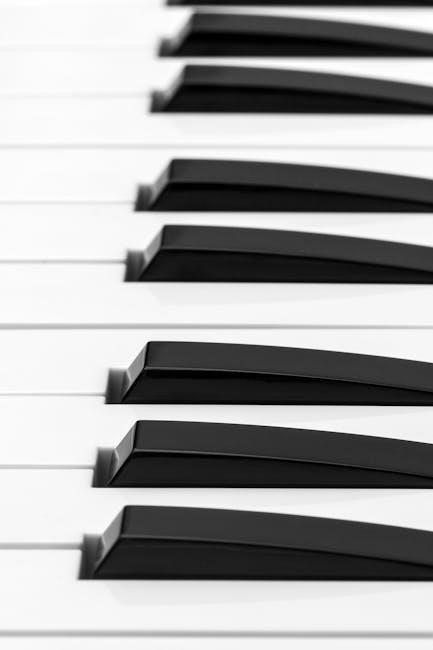
Cultural and Musical Impact of “Let It Be”
“Let It Be” is a culturally significant song, offering comfort and inspiration through its timeless piano melody. Its influence extends beyond music, resonating universally and inspiring countless piano covers, solidifying its legacy in The Beatles’ history.
5.1 The Song’s Role in The Beatles’ Legacy
“Let It Be” holds a poignant place in The Beatles’ legacy as one of their final releases. Its emotional depth and universal message of hope have made it a cherished piece, symbolizing the band’s enduring influence. The song’s piano-driven melody, composed by Paul McCartney, resonates deeply, cementing its status as a timeless classic in their discography and a comforting anthem for generations of music lovers worldwide.
5.2 Influence on Modern Piano Covers and Arrangements
“Let It Be” has inspired countless piano covers and arrangements, with artists worldwide interpreting its melody in various styles. Its versatility allows for both intimate solos and elaborate renditions, making it a favorite among pianists. The song’s timeless appeal continues to influence modern musicians, ensuring its place in the repertoire of pianists across generations and genres, from classical to contemporary interpretations.

Paul McCartney and the Piano in “Let It Be”
Paul McCartney’s composition and emotional piano performance in “Let It Be” are central to the song’s essence, creating a timeless and comforting melody that resonates deeply.
6.1 McCartney’s Composition Process
Paul McCartney composed “Let It Be” during a challenging time, drawing inspiration from a dream about his mother, Mary. He developed the melody on piano, creating a simple yet profound structure. The song’s chord progressions and lyrical depth reflect his emotional journey, resulting in a timeless piece that continues to inspire pianists and music enthusiasts alike.
6;2 The Piano’s Role in the Original Recording
The piano played a central role in the original recording of “Let It Be,” with Paul McCartney delivering a heartfelt performance. His playing provided the emotional foundation, blending simple yet powerful chord progressions with a soothing melody. The piano’s prominence in the mix, particularly during the intro and solo, helped shape the song’s tranquil and uplifting atmosphere, making it a standout piece in The Beatles’ discography.

Challenges in Playing “Let It Be” on the Piano
Mastering “Let It Be” on piano involves overcoming both technical and emotional challenges, requiring precise chord transitions and a deep connection to the song’s heartfelt melody.
7.1 Common Difficulties for Pianists
Pianists often struggle with the smooth transition between chords, maintaining a steady rhythm, and capturing the emotional depth of the melody. The song’s slow tempo requires precise timing, while the dynamic shifts between soft and powerful sections can be challenging to master. Additionally, balancing the harmony and melody simultaneously demands strong finger dexterity and control, especially during the iconic intro and bridge sections.
7.2 Overcoming Technical and Interpretive Hurdles
To overcome challenges, pianists can practice chord progressions slowly, focusing on finger placement and transitions. Breaking the piece into sections allows for targeted practice of difficult passages. Emphasizing dynamic control and phrasing helps convey the song’s emotional depth. Recording performances and seeking feedback can also refine technique and interpretation, ensuring a balanced and expressive rendition of this beloved classic.
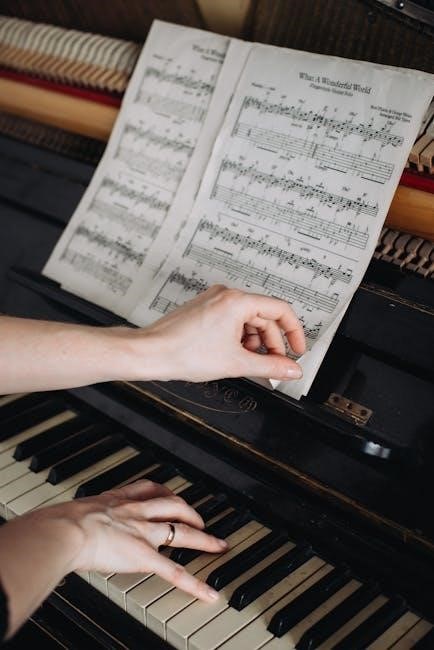
Intermediate and Advanced Piano Arrangements
Addressing technical challenges involves slow, deliberate practice of complex sections. Using a metronome enhances timing accuracy, while dynamic phrasing adds emotional depth. Interpretive hurdles can be overcome by studying McCartney’s original performance, ensuring a balance between technical precision and heartfelt expression, ultimately capturing the song’s essence effectively.
8.1 Arrangements for Intermediate-Level Pianists
Intermediate pianists can explore arrangements of “Let It Be” that balance complexity with accessibility. These versions often include simplified chord progressions and melodies, preserving the song’s emotional depth while remaining technically manageable. Dynamic contrasts and tempo control are emphasized, allowing pianists to develop expressive skills; Resources like MuseScore and SheetMusic-Free.com offer downloadable PDFs tailored for this level, providing clear notation and guidance for a polished performance.
8.2 Advanced Arrangements with Complex Harmonies
Advanced pianists can delve into intricate arrangements of “Let It Be,” featuring complex harmonies, extended chord progressions, and nuanced techniques. These versions often incorporate seventh chords, arpeggios, and elaborate runs, enhancing the song’s depth. Detailed sheet music with advanced notation is available online, offering pianists the opportunity to explore sophisticated interpretations while maintaining the song’s iconic melody and emotional resonance.

Comparing Different Piano Versions of “Let It Be”
Various piano arrangements of “Let It Be” range from simple melodies to intricate versions, showcasing diverse styles and emotional depths while preserving the song’s iconic essence.
9.1 Original Version vs. Covers
The original version of “Let It Be” features McCartney’s emotive piano and intimate vocals, capturing a raw, heartfelt feel. Covers by pianists often reinterpret the melody, incorporating unique styles and arrangements while maintaining the song’s essence. Some versions enhance the piano’s role, adding complex harmonies or solos, creating fresh yet respectful interpretations of the classic piece.
9.2 Instrumental and Vocal-Accompanied Versions
The piano-driven instrumental versions of “Let It Be” highlight the song’s emotional depth, focusing solely on the melody and harmonies. Vocal-accompanied versions, featuring McCartney’s heartfelt lyrics, add another layer of expression, blending the piano with the voice. Both formats are popular in sheet music downloads, offering pianists the flexibility to perform the piece either as a solo instrumental or with vocal accompaniment, preserving the song’s timeless appeal.
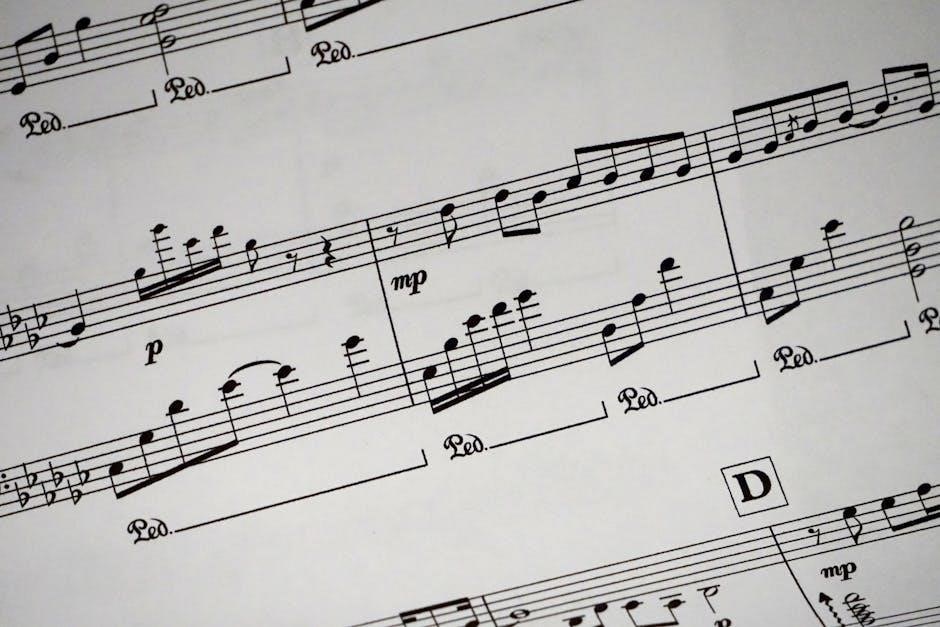
The Beatles’ Discography and Piano Music
The Beatles’ discography features numerous piano-driven songs, with “Let It Be” standing out as a timeless classic. Their music evolved significantly, showcasing the piano’s integral role in their compositions.
10.1 Other Piano-Driven Songs by The Beatles
Beyond “Let It Be,” The Beatles crafted many piano-centric masterpieces. “Hey Jude,” “Yesterday,” and “A Day in the Life” showcase their versatility. These songs highlight the piano’s emotional depth, blending melody and harmony seamlessly. Each piece reflects the band’s evolving artistry, with the piano often at the heart of their musical storytelling and innovation.
10.2 The Evolution of Piano in Their Music
The Beatles’ use of piano evolved significantly, from early rock ‘n’ roll to intricate arrangements. In songs like “Let It Be” and “Hey Jude,” the piano became a central narrative tool, offering emotional depth and complexity. This progression highlights their musical growth, blending simplicity with sophistication to create timeless classics that resonate with pianists and fans alike.
Live Performances and Piano Covers
Paul McCartney’s intimate piano performances of “Let It Be” are iconic. The song has also been beautifully covered by pianists worldwide, showcasing its timeless appeal.
11.1 Notable Live Performances of “Let It Be”
Paul McCartney’s live performances of “Let It Be” are deeply moving, often featuring his soulful piano playing. In the 1970s, he performed the song during The Beatles’ final days. A memorable rendition occurred in the documentary Let It Be, showcasing the song’s raw emotion. McCartney has also played it in solo concerts, emphasizing the piano’s central role. These performances highlight the song’s enduring power and connection with audiences worldwide.
11.2 Famous Piano Covers by Other Artists
“Let It Be” has inspired countless piano covers by renowned artists, each adding their unique touch. Pianists like Elton John and Alicia Keys have delivered emotive renditions, while classical artists offer elegant interpretations. These covers highlight the song’s versatility and timeless appeal, resonating with audiences across genres. Many of these versions are available as sheet music, allowing pianists to explore diverse arrangements and styles, further cementing the song’s legacy in modern music culture.

The Future of Sheet Music Distribution
Digital platforms are revolutionizing sheet music distribution, offering instant access to high-quality PDFs. Interactive tools and apps enhance learning, making piano music more accessible and engaging for musicians worldwide.
12.1 Digital Platforms and Their Impact
Digital platforms have transformed how musicians access sheet music, offering instant downloads and interactive tools. Websites like MuseScore provide free and paid options for “Let It Be” piano sheets, catering to all skill levels. These platforms enable global accessibility, fostering a community of pianists who can learn and share music effortlessly; The shift to digital reduces environmental impact and ensures timeless classics remain accessible for future generations.
12.2 The Role of PDF in Modern Music Sharing
PDFs are a cornerstone in modern music sharing, offering high-quality, print-ready sheet music. For “Let It Be,” PDFs provide precise notation, ensuring accuracy and clarity. They are easily downloadable from sites like MuseScore or Ko-fi, making them accessible to pianists worldwide. PDFs maintain the integrity of the original composition, allowing artists to faithfully reproduce The Beatles’ timeless work, and their universal compatibility ensures they remain a preferred format for musicians and educators alike.
“Let It Be” remains a timeless classic, with its piano arrangement captivating pianists worldwide. The availability of sheet music in PDF format ensures accessibility and quality, inspiring musicians to embrace its enduring beauty and emotional depth.
13.1 Final Thoughts on “Let It Be” and Its Piano Arrangements
“Let It Be” stands as a testament to The Beatles’ musical genius, with its piano arrangement offering both simplicity and depth. The availability of sheet music in PDF format has made it accessible to pianists of all levels, ensuring that this iconic piece continues to inspire and be performed for generations. Its enduring appeal lies in its emotional resonance and timeless melody, making it a cherished piece in piano repertoire.
13.2 Encouragement for Aspiring Pianists
Aspiring pianists are encouraged to embrace “Let It Be” as a beautiful journey of musical growth. With accessible sheet music and tutorials available, learners can explore its emotional depth and timeless melody. Whether playing the iconic intro or mastering the chord progressions, this song offers a rewarding experience. Let its simplicity and complexity inspire you to connect with its universal message, fostering both technical skill and artistic expression.

